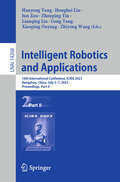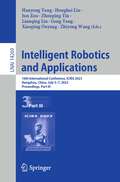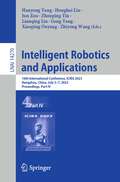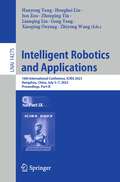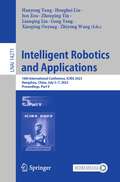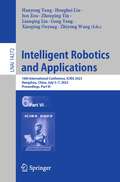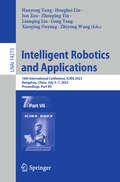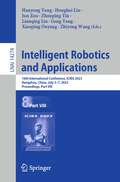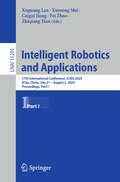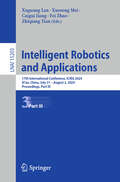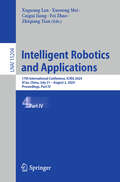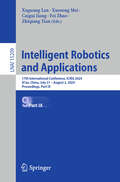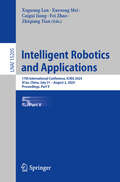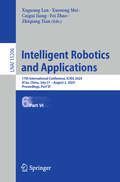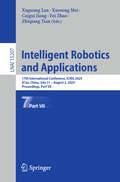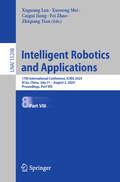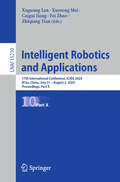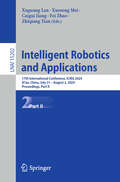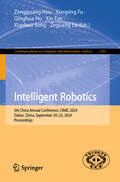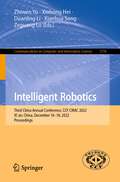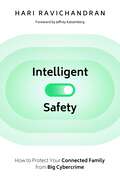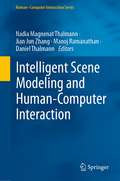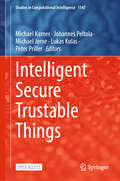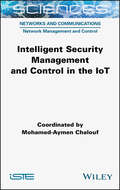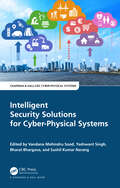- Table View
- List View
Intelligent Robotics and Applications: 16th International Conference, ICIRA 2023, Hangzhou, China, July 5–7, 2023, Proceedings, Part II (Lecture Notes in Computer Science #14268)
by Honghai Liu Zhouping Yin Huayong Yang Lianqing Liu Geng Yang Jun Zou Xiaoping Ouyang Zhiyong WangThe 9-volume set LNAI 14267-14275 constitutes the proceedings of the 16th International Conference on Intelligent Robotics and Applications, ICIRA 2023, which took place in Hangzhou, China, during July 5–7, 2023. The 413 papers included in these proceedings were carefully reviewed and selected from 630 submissions. They were organized in topical sections as follows: Part I: Human-Centric Technologies for Seamless Human-Robot Collaboration; Multimodal Collaborative Perception and Fusion; Intelligent Robot Perception in Unknown Environments; Vision-Based Human Robot Interaction and Application. Part II: Vision-Based Human Robot Interaction and Application; Reliable AI on Machine Human Reactions; Wearable Sensors and Robots; Wearable Robots for Assistance, Augmentation and Rehabilitation of Human Movements; Perception and Manipulation of Dexterous Hand for Humanoid Robot. Part III: Perception and Manipulation of Dexterous Hand for Humanoid Robot; Medical Imaging for Biomedical Robotics; Advanced Underwater Robot Technologies; Innovative Design and Performance Evaluation of Robot Mechanisms; Evaluation of Wearable Robots for Assistance and Rehabilitation; 3D Printing Soft Robots. Part IV: 3D Printing Soft Robots; Dielectric Elastomer Actuators for Soft Robotics; Human-like Locomotion and Manipulation; Pattern Recognition and Machine Learning for Smart Robots. Part V: Pattern Recognition and Machine Learning for Smart Robots; Robotic Tactile Sensation, Perception, and Applications; Advanced Sensing and Control Technology for Human-Robot Interaction; Knowledge-Based Robot Decision-Making and Manipulation; Design and Control of Legged Robots. Part VI: Design and Control of Legged Robots; Robots in Tunnelling and Underground Space; Robotic Machining of Complex Components; Clinically Oriented Design in Robotic Surgery and Rehabilitation; Visual and Visual-Tactile Perception for Robotics. Part VII: Visual and Visual-Tactile Perception for Robotics; Perception, Interaction, and Control of Wearable Robots; Marine Robotics and Applications; Multi-Robot Systems for Real World Applications; Physical and Neurological Human-Robot Interaction. Part VIII: Physical and Neurological Human-Robot Interaction; Advanced Motion Control Technologies for Mobile Robots; Intelligent Inspection Robotics; Robotics in Sustainable Manufacturing for Carbon Neutrality; Innovative Design and Performance Evaluation of Robot Mechanisms. Part IX: Innovative Design and Performance Evaluation of Robot Mechanisms; Cutting-Edge Research in Robotics.
Intelligent Robotics and Applications: 16th International Conference, ICIRA 2023, Hangzhou, China, July 5–7, 2023, Proceedings, Part III (Lecture Notes in Computer Science #14269)
by Honghai Liu Zhouping Yin Huayong Yang Lianqing Liu Geng Yang Jun Zou Xiaoping Ouyang Zhiyong WangThe 9-volume set LNAI 14267-14275 constitutes the proceedings of the 16th International Conference on Intelligent Robotics and Applications, ICIRA 2023, which took place in Hangzhou, China, during July 5–7, 2023.The 413 papers included in these proceedings were carefully reviewed and selected from 630 submissions. They were organized in topical sections as follows:Part I: Human-Centric Technologies for Seamless Human-Robot Collaboration; Multimodal Collaborative Perception and Fusion; Intelligent Robot Perception in Unknown Environments; Vision-Based Human Robot Interaction and Application.Part II: Vision-Based Human Robot Interaction and Application; Reliable AI on Machine Human Reactions; Wearable Sensors and Robots; Wearable Robots for Assistance, Augmentation and Rehabilitation of Human Movements; Perception and Manipulation of Dexterous Hand for Humanoid Robot.Part III: Perception and Manipulation of Dexterous Hand for Humanoid Robot; Medical Imaging for Biomedical Robotics; Advanced Underwater Robot Technologies; Innovative Design and Performance Evaluation of Robot Mechanisms; Evaluation of Wearable Robots for Assistance and Rehabilitation; 3D Printing Soft Robots.Part IV: 3D Printing Soft Robots; Dielectric Elastomer Actuators for Soft Robotics; Human-like Locomotion and Manipulation; Pattern Recognition and Machine Learning for Smart Robots.Part V: Pattern Recognition and Machine Learning for Smart Robots; Robotic Tactile Sensation, Perception, and Applications; Advanced Sensing and Control Technology for Human-Robot Interaction; Knowledge-Based Robot Decision-Making and Manipulation; Design and Control of Legged Robots.Part VI: Design and Control of Legged Robots; Robots in Tunnelling and Underground Space; Robotic Machining of Complex Components; Clinically Oriented Design in Robotic Surgery and Rehabilitation; Visual and Visual-Tactile Perception for Robotics.Part VII: Visual and Visual-Tactile Perception for Robotics; Perception, Interaction, and Control of Wearable Robots; Marine Robotics and Applications; Multi-Robot Systems for Real World Applications; Physical and Neurological Human-Robot Interaction.Part VIII: Physical and Neurological Human-Robot Interaction; Advanced Motion Control Technologies for Mobile Robots; Intelligent Inspection Robotics; Robotics in Sustainable Manufacturing for Carbon Neutrality; Innovative Design and Performance Evaluation of Robot Mechanisms.Part IX: Innovative Design and Performance Evaluation of Robot Mechanisms; Cutting-Edge Research in Robotics.
Intelligent Robotics and Applications: 16th International Conference, ICIRA 2023, Hangzhou, China, July 5–7, 2023, Proceedings, Part IV (Lecture Notes in Computer Science #14270)
by Honghai Liu Zhouping Yin Huayong Yang Lianqing Liu Geng Yang Jun Zou Xiaoping Ouyang Zhiyong WangThe 9-volume set LNAI 14267-14275 constitutes the proceedings of the 16th International Conference on Intelligent Robotics and Applications, ICIRA 2023, which took place in Hangzhou, China, during July 5–7, 2023.The 413 papers included in these proceedings were carefully reviewed and selected from 630 submissions. They were organized in topical sections as follows:Part I: Human-Centric Technologies for Seamless Human-Robot Collaboration; Multimodal Collaborative Perception and Fusion; Intelligent Robot Perception in Unknown Environments; Vision-Based Human Robot Interaction and Application.Part II: Vision-Based Human Robot Interaction and Application; Reliable AI on Machine Human Reactions; Wearable Sensors and Robots; Wearable Robots for Assistance, Augmentation and Rehabilitation of Human Movements; Perception and Manipulation of Dexterous Hand for Humanoid Robot.Part III: Perception and Manipulation of Dexterous Hand for Humanoid Robot; Medical Imaging for Biomedical Robotics; Advanced Underwater Robot Technologies; Innovative Design and Performance Evaluation of Robot Mechanisms; Evaluation of Wearable Robots for Assistance and Rehabilitation; 3D Printing Soft Robots.Part IV: 3D Printing Soft Robots; Dielectric Elastomer Actuators for Soft Robotics; Human-like Locomotion and Manipulation; Pattern Recognition and Machine Learning for Smart Robots.Part V: Pattern Recognition and Machine Learning for Smart Robots; Robotic Tactile Sensation, Perception, and Applications; Advanced Sensing and Control Technology for Human-Robot Interaction; Knowledge-Based Robot Decision-Making and Manipulation; Design and Control of Legged Robots.Part VI: Design and Control of Legged Robots; Robots in Tunnelling and Underground Space; Robotic Machining of Complex Components; Clinically Oriented Design in Robotic Surgery and Rehabilitation; Visual and Visual-Tactile Perception for Robotics.Part VII: Visual and Visual-Tactile Perception for Robotics; Perception, Interaction, and Control of Wearable Robots; Marine Robotics and Applications; Multi-Robot Systems for Real World Applications; Physical and Neurological Human-Robot Interaction.Part VIII: Physical and Neurological Human-Robot Interaction; Advanced Motion Control Technologies for Mobile Robots; Intelligent Inspection Robotics; Robotics in Sustainable Manufacturing for Carbon Neutrality; Innovative Design and Performance Evaluation of Robot Mechanisms.Part IX: Innovative Design and Performance Evaluation of Robot Mechanisms; Cutting-Edge Research in Robotics.
Intelligent Robotics and Applications: 16th International Conference, ICIRA 2023, Hangzhou, China, July 5–7, 2023, Proceedings, Part IX (Lecture Notes in Computer Science #14275)
by Honghai Liu Zhouping Yin Huayong Yang Lianqing Liu Geng Yang Jun Zou Xiaoping Ouyang Zhiyong WangThe 9-volume set LNAI 14267-14275 constitutes the proceedings of the 16th International Conference on Intelligent Robotics and Applications, ICIRA 2023, which took place in Hangzhou, China, during July 5–7, 2023.The 413 papers included in these proceedings were carefully reviewed and selected from 630 submissions. They were organized in topical sections as follows:Part I: Human-Centric Technologies for Seamless Human-Robot Collaboration; Multimodal Collaborative Perception and Fusion; Intelligent Robot Perception in Unknown Environments; Vision-Based Human Robot Interaction and Application.Part II: Vision-Based Human Robot Interaction and Application; Reliable AI on Machine Human Reactions; Wearable Sensors and Robots; Wearable Robots for Assistance, Augmentation and Rehabilitation of Human Movements; Perception and Manipulation of Dexterous Hand for Humanoid Robot.Part III: Perception and Manipulation of Dexterous Hand for Humanoid Robot; Medical Imaging for Biomedical Robotics; Advanced Underwater Robot Technologies; Innovative Design and Performance Evaluation of Robot Mechanisms; Evaluation of Wearable Robots for Assistance and Rehabilitation; 3D Printing Soft Robots.Part IV: 3D Printing Soft Robots; Dielectric Elastomer Actuators for Soft Robotics; Human-like Locomotion and Manipulation; Pattern Recognition and Machine Learning for Smart Robots.Part V: Pattern Recognition and Machine Learning for Smart Robots; Robotic Tactile Sensation, Perception, and Applications; Advanced Sensing and Control Technology for Human-Robot Interaction; Knowledge-Based Robot Decision-Making and Manipulation; Design and Control of Legged Robots.Part VI: Design and Control of Legged Robots; Robots in Tunnelling and Underground Space; Robotic Machining of Complex Components; Clinically Oriented Design in Robotic Surgery and Rehabilitation; Visual and Visual-Tactile Perception for Robotics.Part VII: Visual and Visual-Tactile Perception for Robotics; Perception, Interaction, and Control of Wearable Robots; Marine Robotics and Applications; Multi-Robot Systems for Real World Applications; Physical and Neurological Human-Robot Interaction.Part VIII: Physical and Neurological Human-Robot Interaction; Advanced Motion Control Technologies for Mobile Robots; Intelligent Inspection Robotics; Robotics in Sustainable Manufacturing for Carbon Neutrality; Innovative Design and Performance Evaluation of Robot Mechanisms.Part IX: Innovative Design and Performance Evaluation of Robot Mechanisms; Cutting-Edge Research in Robotics.
Intelligent Robotics and Applications: 16th International Conference, ICIRA 2023, Hangzhou, China, July 5–7, 2023, Proceedings, Part V (Lecture Notes in Computer Science #14271)
by Honghai Liu Zhouping Yin Huayong Yang Lianqing Liu Geng Yang Jun Zou Xiaoping Ouyang Zhiyong WangThe 9-volume set LNAI 14267-14275 constitutes the proceedings of the 16th International Conference on Intelligent Robotics and Applications, ICIRA 2023, which took place in Hangzhou, China, during July 5–7, 2023.The 413 papers included in these proceedings were carefully reviewed and selected from 630 submissions. They were organized in topical sections as follows:Part I: Human-Centric Technologies for Seamless Human-Robot Collaboration; Multimodal Collaborative Perception and Fusion; Intelligent Robot Perception in Unknown Environments; Vision-Based Human Robot Interaction and Application.Part II: Vision-Based Human Robot Interaction and Application; Reliable AI on Machine Human Reactions; Wearable Sensors and Robots; Wearable Robots for Assistance, Augmentation and Rehabilitation of Human Movements; Perception and Manipulation of Dexterous Hand for Humanoid Robot.Part III: Perception and Manipulation of Dexterous Hand for Humanoid Robot; Medical Imaging for Biomedical Robotics; Advanced Underwater Robot Technologies; Innovative Design and Performance Evaluation of Robot Mechanisms; Evaluation of Wearable Robots for Assistance and Rehabilitation; 3D Printing Soft Robots.Part IV: 3D Printing Soft Robots; Dielectric Elastomer Actuators for Soft Robotics; Human-like Locomotion and Manipulation; Pattern Recognition and Machine Learning for Smart Robots.Part V: Pattern Recognition and Machine Learning for Smart Robots; Robotic Tactile Sensation, Perception, and Applications; Advanced Sensing and Control Technology for Human-Robot Interaction; Knowledge-Based Robot Decision-Making and Manipulation; Design and Control of Legged Robots.Part VI: Design and Control of Legged Robots; Robots in Tunnelling and Underground Space; Robotic Machining of Complex Components; Clinically Oriented Design in Robotic Surgery and Rehabilitation; Visual and Visual-Tactile Perception for Robotics.Part VII: Visual and Visual-Tactile Perception for Robotics; Perception, Interaction, and Control of Wearable Robots; Marine Robotics and Applications; Multi-Robot Systems for Real World Applications; Physical and Neurological Human-Robot Interaction.Part VIII: Physical and Neurological Human-Robot Interaction; Advanced Motion Control Technologies for Mobile Robots; Intelligent Inspection Robotics; Robotics in Sustainable Manufacturing for Carbon Neutrality; Innovative Design and Performance Evaluation of Robot Mechanisms.Part IX: Innovative Design and Performance Evaluation of Robot Mechanisms; Cutting-Edge Research in Robotics.
Intelligent Robotics and Applications: 16th International Conference, ICIRA 2023, Hangzhou, China, July 5–7, 2023, Proceedings, Part VI (Lecture Notes in Computer Science #14272)
by Honghai Liu Zhouping Yin Huayong Yang Lianqing Liu Geng Yang Jun Zou Xiaoping Ouyang Zhiyong WangThe 9-volume set LNAI 14267-14275 constitutes the proceedings of the 16th International Conference on Intelligent Robotics and Applications, ICIRA 2023, which took place in Hangzhou, China, during July 5–7, 2023.The 413 papers included in these proceedings were carefully reviewed and selected from 630 submissions. They were organized in topical sections as follows:Part I: Human-Centric Technologies for Seamless Human-Robot Collaboration; Multimodal Collaborative Perception and Fusion; Intelligent Robot Perception in Unknown Environments; Vision-Based Human Robot Interaction and Application.Part II: Vision-Based Human Robot Interaction and Application; Reliable AI on Machine Human Reactions; Wearable Sensors and Robots; Wearable Robots for Assistance, Augmentation and Rehabilitation of Human Movements; Perception and Manipulation of Dexterous Hand for Humanoid Robot.Part III: Perception and Manipulation of Dexterous Hand for Humanoid Robot; Medical Imaging for Biomedical Robotics; Advanced Underwater Robot Technologies; Innovative Design and Performance Evaluation of Robot Mechanisms; Evaluation of Wearable Robots for Assistance and Rehabilitation; 3D Printing Soft Robots.Part IV: 3D Printing Soft Robots; Dielectric Elastomer Actuators for Soft Robotics; Human-like Locomotion and Manipulation; Pattern Recognition and Machine Learning for Smart Robots.Part V: Pattern Recognition and Machine Learning for Smart Robots; Robotic Tactile Sensation, Perception, and Applications; Advanced Sensing and Control Technology for Human-Robot Interaction; Knowledge-Based Robot Decision-Making and Manipulation; Design and Control of Legged Robots.Part VI: Design and Control of Legged Robots; Robots in Tunnelling and Underground Space; Robotic Machining of Complex Components; Clinically Oriented Design in Robotic Surgery and Rehabilitation; Visual and Visual-Tactile Perception for Robotics.Part VII: Visual and Visual-Tactile Perception for Robotics; Perception, Interaction, and Control of Wearable Robots; Marine Robotics and Applications; Multi-Robot Systems for Real World Applications; Physical and Neurological Human-Robot Interaction.Part VIII: Physical and Neurological Human-Robot Interaction; Advanced Motion Control Technologies for Mobile Robots; Intelligent Inspection Robotics; Robotics in Sustainable Manufacturing for Carbon Neutrality; Innovative Design and Performance Evaluation of Robot Mechanisms.Part IX: Innovative Design and Performance Evaluation of Robot Mechanisms; Cutting-Edge Research in Robotics.
Intelligent Robotics and Applications: 16th International Conference, ICIRA 2023, Hangzhou, China, July 5–7, 2023, Proceedings, Part VII (Lecture Notes in Computer Science #14273)
by Honghai Liu Zhouping Yin Huayong Yang Lianqing Liu Geng Yang Jun Zou Xiaoping Ouyang Zhiyong WangThe 9-volume set LNAI 14267-14275 constitutes the proceedings of the 16th International Conference on Intelligent Robotics and Applications, ICIRA 2023, which took place in Hangzhou, China, during July 5–7, 2023.The 413 papers included in these proceedings were carefully reviewed and selected from 630 submissions. They were organized in topical sections as follows:Part I: Human-Centric Technologies for Seamless Human-Robot Collaboration; Multimodal Collaborative Perception and Fusion; Intelligent Robot Perception in Unknown Environments; Vision-Based Human Robot Interaction and Application.Part II: Vision-Based Human Robot Interaction and Application; Reliable AI on Machine Human Reactions; Wearable Sensors and Robots; Wearable Robots for Assistance, Augmentation and Rehabilitation of Human Movements; Perception and Manipulation of Dexterous Hand for Humanoid Robot.Part III: Perception and Manipulation of Dexterous Hand for Humanoid Robot; Medical Imaging for Biomedical Robotics; Advanced Underwater Robot Technologies; Innovative Design and Performance Evaluation of Robot Mechanisms; Evaluation of Wearable Robots for Assistance and Rehabilitation; 3D Printing Soft Robots.Part IV: 3D Printing Soft Robots; Dielectric Elastomer Actuators for Soft Robotics; Human-like Locomotion and Manipulation; Pattern Recognition and Machine Learning for Smart Robots.Part V: Pattern Recognition and Machine Learning for Smart Robots; Robotic Tactile Sensation, Perception, and Applications; Advanced Sensing and Control Technology for Human-Robot Interaction; Knowledge-Based Robot Decision-Making and Manipulation; Design and Control of Legged Robots.Part VI: Design and Control of Legged Robots; Robots in Tunnelling and Underground Space; Robotic Machining of Complex Components; Clinically Oriented Design in Robotic Surgery and Rehabilitation; Visual and Visual-Tactile Perception for Robotics.Part VII: Visual and Visual-Tactile Perception for Robotics; Perception, Interaction, and Control of Wearable Robots; Marine Robotics and Applications; Multi-Robot Systems for Real World Applications; Physical and Neurological Human-Robot Interaction.Part VIII: Physical and Neurological Human-Robot Interaction; Advanced Motion Control Technologies for Mobile Robots; Intelligent Inspection Robotics; Robotics in Sustainable Manufacturing for Carbon Neutrality; Innovative Design and Performance Evaluation of Robot Mechanisms.Part IX: Innovative Design and Performance Evaluation of Robot Mechanisms; Cutting-Edge Research in Robotics.
Intelligent Robotics and Applications: 16th International Conference, ICIRA 2023, Hangzhou, China, July 5–7, 2023, Proceedings, Part VIII (Lecture Notes in Computer Science #14274)
by Honghai Liu Zhouping Yin Huayong Yang Lianqing Liu Geng Yang Jun Zou Xiaoping Ouyang Zhiyong WangThe 9-volume set LNAI 14267-14275 constitutes the proceedings of the 16th International Conference on Intelligent Robotics and Applications, ICIRA 2023, which took place in Hangzhou, China, during July 5–7, 2023.The 413 papers included in these proceedings were carefully reviewed and selected from 630 submissions. They were organized in topical sections as follows:Part I: Human-Centric Technologies for Seamless Human-Robot Collaboration; Multimodal Collaborative Perception and Fusion; Intelligent Robot Perception in Unknown Environments; Vision-Based Human Robot Interaction and Application.Part II: Vision-Based Human Robot Interaction and Application; Reliable AI on Machine Human Reactions; Wearable Sensors and Robots; Wearable Robots for Assistance, Augmentation and Rehabilitation of Human Movements; Perception and Manipulation of Dexterous Hand for Humanoid Robot.Part III: Perception and Manipulation of Dexterous Hand for Humanoid Robot; Medical Imaging for Biomedical Robotics; Advanced Underwater Robot Technologies; Innovative Design and Performance Evaluation of Robot Mechanisms; Evaluation of Wearable Robots for Assistance and Rehabilitation; 3D Printing Soft Robots.Part IV: 3D Printing Soft Robots; Dielectric Elastomer Actuators for Soft Robotics; Human-like Locomotion and Manipulation; Pattern Recognition and Machine Learning for Smart Robots.Part V: Pattern Recognition and Machine Learning for Smart Robots; Robotic Tactile Sensation, Perception, and Applications; Advanced Sensing and Control Technology for Human-Robot Interaction; Knowledge-Based Robot Decision-Making and Manipulation; Design and Control of Legged Robots.Part VI: Design and Control of Legged Robots; Robots in Tunnelling and Underground Space; Robotic Machining of Complex Components; Clinically Oriented Design in Robotic Surgery and Rehabilitation; Visual and Visual-Tactile Perception for Robotics.Part VII: Visual and Visual-Tactile Perception for Robotics; Perception, Interaction, and Control of Wearable Robots; Marine Robotics and Applications; Multi-Robot Systems for Real World Applications; Physical and Neurological Human-Robot Interaction.Part VIII: Physical and Neurological Human-Robot Interaction; Advanced Motion Control Technologies for Mobile Robots; Intelligent Inspection Robotics; Robotics in Sustainable Manufacturing for Carbon Neutrality; Innovative Design and Performance Evaluation of Robot Mechanisms.Part IX: Innovative Design and Performance Evaluation of Robot Mechanisms; Cutting-Edge Research in Robotics.
Intelligent Robotics and Applications: 17th International Conference, ICIRA 2024, Xi'an, China, July 31 – August 2, 2024, Proceedings, Part I (Lecture Notes in Computer Science #15201)
by Xuguang Lan Xuesong Mei Caigui Jiang Fei Zhao Zhiqiang TianThe 10-volume set LNAI 15201-15210 constitutes the proceedings of the 17th International Conference on Intelligent Robotics and Applications, ICIRA 2024, which took place in Xi’an, China, during July 31–August 2, 2024. The 321 full papers included in these proceedings were carefully reviewed and selected from 489 submissions. They were organized in topical sections as follows: Part I: Innovative Design and Performance Evaluation of Robot Mechanisms. Part II: Robot Perception and Machine Learning; Cognitive Intelligence and Security Control for Multi-domain Unmanned Vehicle Systems. Part III: Emerging Techniques for Intelligent Robots in Unstructured Environment; Soft Actuators and Sensors; and Advanced Intelligent and Flexible Sensor Technologies for Robotics. Part IV: Optimization and Intelligent Control of Underactuated Robotic Systems; and Technology and application of modular robots. Part V: Advanced actuation and intelligent control in medical robotics: Advancements in Machine Vision for Enhancing Human-Robot Interaction; and Hybrid Decision-making and Control for Intelligent Robots. Part VI: Advances in Marine Robotics; Visual, Linguistic, Affective Agents: Hybrid-augmented Agents for Robotics; and Wearable Robots for Assistance, Augmentation and Rehabilitation of human movements. Part VII: Integrating World Models for Enhanced Robotic Autonomy; Advanced Sensing and Control Technologies for Intelligent Human-Robot Interaction; and Mini-Invasive Robotics for In-Situ Manipulation. Part VIII: Robot Skill Learning and Transfer; Human-Robot Dynamic System: Learning, Modelling and Control; AI-Driven Smart Industrial Systems; and Natural Interaction and Coordinated Collaboration of Robots in Dynamic Unstructured Environments. Part IX: Robotics in Cooperative Manipulation, MultiSensor Fusion, and Multi-Robot Systems; Human-machine Co-adaptive Interface; Brain inspired intelligence for robotics; Planning, control and application of bionic novel concept robots; and Robust Perception for Safe Driving. Part X: AI Robot Technology for Healthcare as a Service; Computational Neuroscience and Cognitive Models for Adaptive Human-Robot Interactions; Dynamics and Perception of Human-Robot Hybrid Systems; and Robotics for Rehabilitation: Innovations, Challenges, and Future Directions.
Intelligent Robotics and Applications: 17th International Conference, ICIRA 2024, Xi'an, China, July 31 – August 2, 2024, Proceedings, Part III (Lecture Notes in Computer Science #15203)
by Xuguang Lan Xuesong Mei Caigui Jiang Fei Zhao Zhiqiang TianThe 10-volume set LNAI 15201-15210 constitutes the proceedings of the 17th International Conference on Intelligent Robotics and Applications, ICIRA 2024, which took place in Xi’an, China, during July 31–August 2, 2024. The 321 full papers included in these proceedings were carefully reviewed and selected from 489 submissions. They were organized in topical sections as follows: Part I: Innovative Design and Performance Evaluation of Robot Mechanisms. Part II: Robot Perception and Machine Learning; Cognitive Intelligence and Security Control for Multi-domain Unmanned Vehicle Systems. Part III: Emerging Techniques for Intelligent Robots in Unstructured Environment; Soft Actuators and Sensors; and Advanced Intelligent and Flexible Sensor Technologies for Robotics. Part IV: Optimization and Intelligent Control of Underactuated Robotic Systems; and Technology and application of modular robots. Part V: Advanced actuation and intelligent control in medical robotics: Advancements in Machine Vision for Enhancing Human-Robot Interaction; and Hybrid Decision-making and Control for Intelligent Robots. Part VI: Advances in Marine Robotics; Visual, Linguistic, Affective Agents: Hybrid-augmented Agents for Robotics; and Wearable Robots for Assistance, Augmentation and Rehabilitation of human movements. Part VII: Integrating World Models for Enhanced Robotic Autonomy; Advanced Sensing and Control Technologies for Intelligent Human-Robot Interaction; and Mini-Invasive Robotics for In-Situ Manipulation. Part VIII: Robot Skill Learning and Transfer; Human-Robot Dynamic System: Learning, Modelling and Control; AI-Driven Smart Industrial Systems; and Natural Interaction and Coordinated Collaboration of Robots in Dynamic Unstructured Environments. Part IX: Robotics in Cooperative Manipulation, MultiSensor Fusion, and Multi-Robot Systems; Human-machine Co-adaptive Interface; Brain inspired intelligence for robotics; Planning, control and application of bionic novel concept robots; and Robust Perception for Safe Driving. Part X: AI Robot Technology for Healthcare as a Service; Computational Neuroscience and Cognitive Models for Adaptive Human-Robot Interactions; Dynamics and Perception of Human-Robot Hybrid Systems; and Robotics for Rehabilitation: Innovations, Challenges, and Future Directions.
Intelligent Robotics and Applications: 17th International Conference, ICIRA 2024, Xi'an, China, July 31 – August 2, 2024, Proceedings, Part IV (Lecture Notes in Computer Science #15204)
by Xuguang Lan Xuesong Mei Caigui Jiang Fei Zhao Zhiqiang TianThe 10-volume set LNAI 15201-15210 constitutes the proceedings of the 17th International Conference on Intelligent Robotics and Applications, ICIRA 2024, which took place in Xi’an, China, during July 31–August 2, 2024. The 321 full papers included in these proceedings were carefully reviewed and selected from 489 submissions. They were organized in topical sections as follows: Part I: Innovative Design and Performance Evaluation of Robot Mechanisms. Part II: Robot Perception and Machine Learning; Cognitive Intelligence and Security Control for Multi-domain Unmanned Vehicle Systems. Part III: Emerging Techniques for Intelligent Robots in Unstructured Environment; Soft Actuators and Sensors; and Advanced Intelligent and Flexible Sensor Technologies for Robotics. Part IV: Optimization and Intelligent Control of Underactuated Robotic Systems; and Technology and application of modular robots. Part V: Advanced actuation and intelligent control in medical robotics: Advancements in Machine Vision for Enhancing Human-Robot Interaction; and Hybrid Decision-making and Control for Intelligent Robots. Part VI: Advances in Marine Robotics; Visual, Linguistic, Affective Agents: Hybrid-augmented Agents for Robotics; and Wearable Robots for Assistance, Augmentation and Rehabilitation of human movements. Part VII: Integrating World Models for Enhanced Robotic Autonomy; Advanced Sensing and Control Technologies for Intelligent Human-Robot Interaction; and Mini-Invasive Robotics for In-Situ Manipulation. Part VIII: Robot Skill Learning and Transfer; Human-Robot Dynamic System: Learning, Modelling and Control; AI-Driven Smart Industrial Systems; and Natural Interaction and Coordinated Collaboration of Robots in Dynamic Unstructured Environments. Part IX: Robotics in Cooperative Manipulation, MultiSensor Fusion, and Multi-Robot Systems; Human-machine Co-adaptive Interface; Brain inspired intelligence for robotics; Planning, control and application of bionic novel concept robots; and Robust Perception for Safe Driving. Part X: AI Robot Technology for Healthcare as a Service; Computational Neuroscience and Cognitive Models for Adaptive Human-Robot Interactions; Dynamics and Perception of Human-Robot Hybrid Systems; and Robotics for Rehabilitation: Innovations, Challenges, and Future Directions.
Intelligent Robotics and Applications: 17th International Conference, ICIRA 2024, Xi'an, China, July 31 – August 2, 2024, Proceedings, Part IX (Lecture Notes in Computer Science #15209)
by Xuguang Lan Xuesong Mei Caigui Jiang Fei Zhao Zhiqiang TianThe 10-volume set LNAI 15201-15210 constitutes the proceedings of the 17th International Conference on Intelligent Robotics and Applications, ICIRA 2024, which took place in Xi’an, China, during July 31–August 2, 2024. The 321 full papers included in these proceedings were carefully reviewed and selected from 489 submissions. They were organized in topical sections as follows: Part I: Innovative Design and Performance Evaluation of Robot Mechanisms. Part II: Robot Perception and Machine Learning; Cognitive Intelligence and Security Control for Multi-domain Unmanned Vehicle Systems. Part III: Emerging Techniques for Intelligent Robots in Unstructured Environment; Soft Actuators and Sensors; and Advanced Intelligent and Flexible Sensor Technologies for Robotics. Part IV: Optimization and Intelligent Control of Underactuated Robotic Systems; and Technology and application of modular robots. Part V: Advanced actuation and intelligent control in medical robotics: Advancements in Machine Vision for Enhancing Human-Robot Interaction; and Hybrid Decision-making and Control for Intelligent Robots. Part VI: Advances in Marine Robotics; Visual, Linguistic, Affective Agents: Hybrid-augmented Agents for Robotics; and Wearable Robots for Assistance, Augmentation and Rehabilitation of human movements. Part VII: Integrating World Models for Enhanced Robotic Autonomy; Advanced Sensing and Control Technologies for Intelligent Human-Robot Interaction; and Mini-Invasive Robotics for In-Situ Manipulation. Part VIII: Robot Skill Learning and Transfer; Human-Robot Dynamic System: Learning, Modelling and Control; AI-Driven Smart Industrial Systems; and Natural Interaction and Coordinated Collaboration of Robots in Dynamic Unstructured Environments. Part IX: Robotics in Cooperative Manipulation, MultiSensor Fusion, and Multi-Robot Systems; Human-machine Co-adaptive Interface; Brain inspired intelligence for robotics; Planning, control and application of bionic novel concept robots; and Robust Perception for Safe Driving. Part X: AI Robot Technology for Healthcare as a Service; Computational Neuroscience and Cognitive Models for Adaptive Human-Robot Interactions; Dynamics and Perception of Human-Robot Hybrid Systems; and Robotics for Rehabilitation: Innovations, Challenges, and Future Directions.
Intelligent Robotics and Applications: 17th International Conference, ICIRA 2024, Xi'an, China, July 31 – August 2, 2024, Proceedings, Part V (Lecture Notes in Computer Science #15205)
by Xuguang Lan Xuesong Mei Caigui Jiang Fei Zhao Zhiqiang TianThe 10-volume set LNAI 15201-15210 constitutes the proceedings of the 17th International Conference on Intelligent Robotics and Applications, ICIRA 2024, which took place in Xi’an, China, during July 31–August 2, 2024. The 321 full papers included in these proceedings were carefully reviewed and selected from 489 submissions. They were organized in topical sections as follows: Part I: Innovative Design and Performance Evaluation of Robot Mechanisms. Part II: Robot Perception and Machine Learning; Cognitive Intelligence and Security Control for Multi-domain Unmanned Vehicle Systems. Part III: Emerging Techniques for Intelligent Robots in Unstructured Environment; Soft Actuators and Sensors; and Advanced Intelligent and Flexible Sensor Technologies for Robotics. Part IV: Optimization and Intelligent Control of Underactuated Robotic Systems; and Technology and application of modular robots. Part V: Advanced actuation and intelligent control in medical robotics: Advancements in Machine Vision for Enhancing Human-Robot Interaction; and Hybrid Decision-making and Control for Intelligent Robots. Part VI: Advances in Marine Robotics; Visual, Linguistic, Affective Agents: Hybrid-augmented Agents for Robotics; and Wearable Robots for Assistance, Augmentation and Rehabilitation of human movements. Part VII: Integrating World Models for Enhanced Robotic Autonomy; Advanced Sensing and Control Technologies for Intelligent Human-Robot Interaction; and Mini-Invasive Robotics for In-Situ Manipulation. Part VIII: Robot Skill Learning and Transfer; Human-Robot Dynamic System: Learning, Modelling and Control; AI-Driven Smart Industrial Systems; and Natural Interaction and Coordinated Collaboration of Robots in Dynamic Unstructured Environments. Part IX: Robotics in Cooperative Manipulation, MultiSensor Fusion, and Multi-Robot Systems; Human-machine Co-adaptive Interface; Brain inspired intelligence for robotics; Planning, control and application of bionic novel concept robots; and Robust Perception for Safe Driving. Part X: AI Robot Technology for Healthcare as a Service; Computational Neuroscience and Cognitive Models for Adaptive Human-Robot Interactions; Dynamics and Perception of Human-Robot Hybrid Systems; and Robotics for Rehabilitation: Innovations, Challenges, and Future Directions.
Intelligent Robotics and Applications: 17th International Conference, ICIRA 2024, Xi'an, China, July 31 – August 2, 2024, Proceedings, Part VI (Lecture Notes in Computer Science #15206)
by Xuguang Lan Xuesong Mei Caigui Jiang Fei Zhao Zhiqiang TianThe 10-volume set LNAI 15201-15210 constitutes the proceedings of the 17th International Conference on Intelligent Robotics and Applications, ICIRA 2024, which took place in Xi’an, China, during July 31–August 2, 2024. The 321 full papers included in these proceedings were carefully reviewed and selected from 489 submissions. They were organized in topical sections as follows: Part I: Innovative Design and Performance Evaluation of Robot Mechanisms. Part II: Robot Perception and Machine Learning; Cognitive Intelligence and Security Control for Multi-domain Unmanned Vehicle Systems. Part III: Emerging Techniques for Intelligent Robots in Unstructured Environment; Soft Actuators and Sensors; and Advanced Intelligent and Flexible Sensor Technologies for Robotics. Part IV: Optimization and Intelligent Control of Underactuated Robotic Systems; and Technology and application of modular robots. Part V: Advanced actuation and intelligent control in medical robotics: Advancements in Machine Vision for Enhancing Human-Robot Interaction; and Hybrid Decision-making and Control for Intelligent Robots. Part VI: Advances in Marine Robotics; Visual, Linguistic, Affective Agents: Hybrid-augmented Agents for Robotics; and Wearable Robots for Assistance, Augmentation and Rehabilitation of human movements. Part VII: Integrating World Models for Enhanced Robotic Autonomy; Advanced Sensing and Control Technologies for Intelligent Human-Robot Interaction; and Mini-Invasive Robotics for In-Situ Manipulation. Part VIII: Robot Skill Learning and Transfer; Human-Robot Dynamic System: Learning, Modelling and Control; AI-Driven Smart Industrial Systems; and Natural Interaction and Coordinated Collaboration of Robots in Dynamic Unstructured Environments. Part IX: Robotics in Cooperative Manipulation, MultiSensor Fusion, and Multi-Robot Systems; Human-machine Co-adaptive Interface; Brain inspired intelligence for robotics; Planning, control and application of bionic novel concept robots; and Robust Perception for Safe Driving. Part X: AI Robot Technology for Healthcare as a Service; Computational Neuroscience and Cognitive Models for Adaptive Human-Robot Interactions; Dynamics and Perception of Human-Robot Hybrid Systems; and Robotics for Rehabilitation: Innovations, Challenges, and Future Directions.
Intelligent Robotics and Applications: 17th International Conference, ICIRA 2024, Xi'an, China, July 31 – August 2, 2024, Proceedings, Part VII (Lecture Notes in Computer Science #15207)
by Xuguang Lan Xuesong Mei Caigui Jiang Fei Zhao Zhiqiang TianThe 10-volume set LNAI 15201-15210 constitutes the proceedings of the 17th International Conference on Intelligent Robotics and Applications, ICIRA 2024, which took place in Xi’an, China, during July 31–August 2, 2024. The 321 full papers included in these proceedings were carefully reviewed and selected from 489 submissions. They were organized in topical sections as follows: Part I: Innovative Design and Performance Evaluation of Robot Mechanisms. Part II: Robot Perception and Machine Learning; Cognitive Intelligence and Security Control for Multi-domain Unmanned Vehicle Systems. Part III: Emerging Techniques for Intelligent Robots in Unstructured Environment; Soft Actuators and Sensors; and Advanced Intelligent and Flexible Sensor Technologies for Robotics. Part IV: Optimization and Intelligent Control of Underactuated Robotic Systems; and Technology and application of modular robots. Part V: Advanced actuation and intelligent control in medical robotics: Advancements in Machine Vision for Enhancing Human-Robot Interaction; and Hybrid Decision-making and Control for Intelligent Robots. Part VI: Advances in Marine Robotics; Visual, Linguistic, Affective Agents: Hybrid-augmented Agents for Robotics; and Wearable Robots for Assistance, Augmentation and Rehabilitation of human movements. Part VII: Integrating World Models for Enhanced Robotic Autonomy; Advanced Sensing and Control Technologies for Intelligent Human-Robot Interaction; and Mini-Invasive Robotics for In-Situ Manipulation. Part VIII: Robot Skill Learning and Transfer; Human-Robot Dynamic System: Learning, Modelling and Control; AI-Driven Smart Industrial Systems; and Natural Interaction and Coordinated Collaboration of Robots in Dynamic Unstructured Environments. Part IX: Robotics in Cooperative Manipulation, MultiSensor Fusion, and Multi-Robot Systems; Human-machine Co-adaptive Interface; Brain inspired intelligence for robotics; Planning, control and application of bionic novel concept robots; and Robust Perception for Safe Driving. Part X: AI Robot Technology for Healthcare as a Service; Computational Neuroscience and Cognitive Models for Adaptive Human-Robot Interactions; Dynamics and Perception of Human-Robot Hybrid Systems; and Robotics for Rehabilitation: Innovations, Challenges, and Future Directions.
Intelligent Robotics and Applications: 17th International Conference, ICIRA 2024, Xi'an, China, July 31 – August 2, 2024, Proceedings, Part VIII (Lecture Notes in Computer Science #15208)
by Xuguang Lan Xuesong Mei Caigui Jiang Fei Zhao Zhiqiang TianThe 10-volume set LNAI 15201-15210 constitutes the proceedings of the 17th International Conference on Intelligent Robotics and Applications, ICIRA 2024, which took place in Xi’an, China, during July 31–August 2, 2024. The 321 full papers included in these proceedings were carefully reviewed and selected from 489 submissions. They were organized in topical sections as follows: Part I: Innovative Design and Performance Evaluation of Robot Mechanisms. Part II: Robot Perception and Machine Learning; Cognitive Intelligence and Security Control for Multi-domain Unmanned Vehicle Systems. Part III: Emerging Techniques for Intelligent Robots in Unstructured Environment; Soft Actuators and Sensors; and Advanced Intelligent and Flexible Sensor Technologies for Robotics. Part IV: Optimization and Intelligent Control of Underactuated Robotic Systems; and Technology and application of modular robots. Part V: Advanced actuation and intelligent control in medical robotics: Advancements in Machine Vision for Enhancing Human-Robot Interaction; and Hybrid Decision-making and Control for Intelligent Robots. Part VI: Advances in Marine Robotics; Visual, Linguistic, Affective Agents: Hybrid-augmented Agents for Robotics; and Wearable Robots for Assistance, Augmentation and Rehabilitation of human movements. Part VII: Integrating World Models for Enhanced Robotic Autonomy; Advanced Sensing and Control Technologies for Intelligent Human-Robot Interaction; and Mini-Invasive Robotics for In-Situ Manipulation. Part VIII: Robot Skill Learning and Transfer; Human-Robot Dynamic System: Learning, Modelling and Control; AI-Driven Smart Industrial Systems; and Natural Interaction and Coordinated Collaboration of Robots in Dynamic Unstructured Environments. Part IX: Robotics in Cooperative Manipulation, MultiSensor Fusion, and Multi-Robot Systems; Human-machine Co-adaptive Interface; Brain inspired intelligence for robotics; Planning, control and application of bionic novel concept robots; and Robust Perception for Safe Driving. Part X: AI Robot Technology for Healthcare as a Service; Computational Neuroscience and Cognitive Models for Adaptive Human-Robot Interactions; Dynamics and Perception of Human-Robot Hybrid Systems; and Robotics for Rehabilitation: Innovations, Challenges, and Future Directions.
Intelligent Robotics and Applications: 17th International Conference, ICIRA 2024, Xi'an, China, July 31–August 2, 2024, Proceedings, Part X (Lecture Notes in Computer Science #15210)
by Xuguang Lan Xuesong Mei Caigui Jiang Fei Zhao Zhiqiang TianThe 10-volume set LNAI 15201-15210 constitutes the proceedings of the 17th International Conference on Intelligent Robotics and Applications, ICIRA 2024, which took place in Xi’an, China, during July 31–August 2, 2024. The 321 full papers included in these proceedings were carefully reviewed and selected from 489 submissions. They were organized in topical sections as follows: Part I: Innovative Design and Performance Evaluation of Robot Mechanisms. Part II: Robot Perception and Machine Learning; Cognitive Intelligence and Security Control for Multi-domain Unmanned Vehicle Systems. Part III: Emerging Techniques for Intelligent Robots in Unstructured Environment; Soft Actuators and Sensors; and Advanced Intelligent and Flexible Sensor Technologies for Robotics. Part IV: Optimization and Intelligent Control of Underactuated Robotic Systems; and Technology and application of modular robots. Part V: Advanced actuation and intelligent control in medical robotics: Advancements in Machine Vision for Enhancing Human-Robot Interaction; and Hybrid Decision-making and Control for Intelligent Robots. Part VI: Advances in Marine Robotics; Visual, Linguistic, Affective Agents: Hybrid-augmented Agents for Robotics; and Wearable Robots for Assistance, Augmentation and Rehabilitation of human movements. Part VII: Integrating World Models for Enhanced Robotic Autonomy; Advanced Sensing and Control Technologies for Intelligent Human-Robot Interaction; and Mini-Invasive Robotics for In-Situ Manipulation. Part VIII: Robot Skill Learning and Transfer; Human-Robot Dynamic System: Learning, Modelling and Control; AI-Driven Smart Industrial Systems; and Natural Interaction and Coordinated Collaboration of Robots in Dynamic Unstructured Environments. Part IX: Robotics in Cooperative Manipulation, MultiSensor Fusion, and Multi-Robot Systems; Human-machine Co-adaptive Interface; Brain inspired intelligence for robotics; Planning, control and application of bionic novel concept robots; and Robust Perception for Safe Driving. Part X: AI Robot Technology for Healthcare as a Service; Computational Neuroscience and Cognitive Models for Adaptive Human-Robot Interactions; Dynamics and Perception of Human-Robot Hybrid Systems; and Robotics for Rehabilitation: Innovations, Challenges, and Future Directions.
Intelligent Robotics and Applications: 17th International Conference, ICIRA 2024, Xi’an, China, July 31 – August 2, 2024, Proceedings, Part II (Lecture Notes in Computer Science #15202)
by Xuguang Lan Xuesong Mei Caigui Jiang Fei Zhao Zhiqiang TianThe 10-volume set LNAI 15201-15210 constitutes the proceedings of the 17th International Conference on Intelligent Robotics and Applications, ICIRA 2024, which took place in Xi’an, China, during July 31–August 2, 2024. The 321 full papers included in these proceedings were carefully reviewed and selected from 489 submissions. They were organized in topical sections as follows: Part I: Innovative Design and Performance Evaluation of Robot Mechanisms. Part II: Robot Perception and Machine Learning; Cognitive Intelligence and Security Control for Multi-domain Unmanned Vehicle Systems. Part III: Emerging Techniques for Intelligent Robots in Unstructured Environment; Soft Actuators and Sensors; and Advanced Intelligent and Flexible Sensor Technologies for Robotics. Part IV: Optimization and Intelligent Control of Underactuated Robotic Systems; and Technology and application of modular robots. Part V: Advanced actuation and intelligent control in medical robotics: Advancements in Machine Vision for Enhancing Human-Robot Interaction; and Hybrid Decision-making and Control for Intelligent Robots. Part VI: Advances in Marine Robotics; Visual, Linguistic, Affective Agents: Hybrid-augmented Agents for Robotics; and Wearable Robots for Assistance, Augmentation and Rehabilitation of human movements. Part VII: Integrating World Models for Enhanced Robotic Autonomy; Advanced Sensing and Control Technologies for Intelligent Human-Robot Interaction; and Mini-Invasive Robotics for In-Situ Manipulation. Part VIII: Robot Skill Learning and Transfer; Human-Robot Dynamic System: Learning, Modelling and Control; AI-Driven Smart Industrial Systems; and Natural Interaction and Coordinated Collaboration of Robots in Dynamic Unstructured Environments. Part IX: Robotics in Cooperative Manipulation, MultiSensor Fusion, and Multi-Robot Systems; Human-machine Co-adaptive Interface; Brain inspired intelligence for robotics; Planning, control and application of bionic novel concept robots; and Robust Perception for Safe Driving. Part X: AI Robot Technology for Healthcare as a Service; Computational Neuroscience and Cognitive Models for Adaptive Human-Robot Interactions; Dynamics and Perception of Human-Robot Hybrid Systems; and Robotics for Rehabilitation: Innovations, Challenges, and Future Directions.
Intelligent Robotics: 5th China Annual Conference, CIRAC 2024, Dalian, China, September 20–22, 2024, Proceedings (Communications in Computer and Information Science #2355)
by Xianhua Song Zeguang Lu Qinghua Hu Xin Fan Zengguang Hou Xianping FuThis book constitutes selected papers presented during the 5th China Annual Intelligent Robotics Conference, CIRAC 2024, held in Dalian, China, in September 2024. The 28 full papers presented in this volume were carefully reviewed and selected from 96 submissions. They are grouped into the following topics: Deep Learning Architecture; Low-Level Vision; Multi-modal learning; Pattern Recognition; Robotics; and Signal processing.
Intelligent Robotics: Third China Annual Conference, CCF CIRAC 2022, Xi’an, China, December 16–18, 2022, Proceedings (Communications in Computer and Information Science #1770)
by Xianhua Song Zeguang Lu Zhiwen Yu Xinhong Hei Duanling LiThis book constitutes selected papers presented during the Third China Annual Intelligent Robotics Conference, CCF CIRAC 2022, held in Xi' an, China, in December 2022. The 35 papers presented were thoroughly reviewed and selected from the 120 qualified submissions. They are organized in the following topical sections: robot safety; intelligent robot sensing; autonomous robot navigation; artificial intelligence and cloud robot; unmanned cluster collaboration; natural human-computer interaction; other robot-related technologies.
Intelligent Safety: How to Protect Your Connected Family from Big Cybercrime
by Hari RavichandranTurn the tables on cybercriminals. Keep your loved ones safe. We live much of our personal and professional lives online, but fraudsters and hackers have made the internet dangerous. Cyberattacks are the US&’s fastest growing crime: consumers lost more than $6.9 billion to fraud in 2021, up more than 50% from 2020; financial losses from online theft surpassed losses from home theft; 1 in 10 people become identity theft victims annually, including more than 1 million children. So how do we keep our kids, parents, colleagues, and selves safe against organized cybercriminals with their increasingly advanced tools?Intelligent Safety: How to Protect Your Connected Family from Big Cybercrime teaches how we can put our families&’ online safety on autopilot and regain our peace of mind. It provides families with the tools and knowledge they need to create a personalized, proactive defense against cybercriminals. From identifying the risks of your teen&’s secret online life to safeguarding your family finances to defending the vulnerabilities of your aging parents, Intelligent Safety is the last guide you&’ll need to beat cyber predators at their own game.
Intelligent Scene Modeling and Human-Computer Interaction (Human–Computer Interaction Series)
by Daniel Thalmann Nadia Magnenat Thalmann Jian Jun Zhang Manoj RamanathanThis edited book is one of the first to describe how Autonomous Virtual Humans and Social Robots can interact with real people and be aware of the surrounding world using machine learning and AI. It includes:· Many algorithms related to the awareness of the surrounding world such as the recognition of objects, the interpretation of various sources of data provided by cameras, microphones, and wearable sensors· Deep Learning Methods to provide solutions to Visual Attention, Quality Perception, and Visual Material Recognition· How Face Recognition and Speech Synthesis will replace the traditional mouse and keyboard interfaces· Semantic modeling and rendering and shows how these domains play an important role in Virtual and Augmented Reality Applications.Intelligent Scene Modeling and Human-Computer Interaction explains how to understand the composition and build very complex scenes and emphasizes the semantic methods needed to have an intelligent interaction with them. It offers readers a unique opportunity to comprehend the rapid changes and continuous development in the fields of Intelligent Scene Modeling.
Intelligent Secure Trustable Things (Studies in Computational Intelligence #1147)
by Michael Karner Johannes Peltola Michael Jerne Lukas Kulas Peter PrillerThis open access book provides an overview about results of the InSecTT project. Artificial Intelligence of Things (AIoT) is the natural evolution for both Artificial Intelligence (AI) and Internet of Things (IoT) because they are mutually beneficial. AI increases the value of the IoT through machine learning by transforming the data into useful information, while the IoT increases the value of AI through connectivity and data exchange. Therefore, InSecTT—Intelligent Secure Trustable Things, a pan-European effort with over 50 key partners from 12 countries (EU and Turkey), provides intelligent, secure and trustworthy systems for industrial applications to provide comprehensive cost-efficient solutions of intelligent, end-to-end secure, trustworthy connectivity and interoperability to bring the Internet of Things and Artificial Intelligence together. InSecTT creates trust in AI-based intelligent systems and solutions as a major part of the AIoT. InSecTT fosters cooperation between big industrial players from various domains, a number of highly innovative SMEs distributed all over Europe and cutting-edge research organizations and universities. The project features a big variety of industry-driven use cases embedded into various application domains where Europe is in a leading position, i.e., smart infrastructure, building, manufacturing, automotive, aeronautics, railway, urban public transport, maritime as well as health. The demonstration of InSecTT solutions in well-known real-world environments like airports, trains, ports and the health sector shows their applicability on both high and broad level, going from citizens to European stakeholders. The first part of the book provides an introduction into the main topics of the InSecTT project: How to bring Internet of Things and Artificial Intelligence together to form the Artificial Intelligence of Things, a reference architecture for such kind of systems and how to develop trustworthy, ethical AI systems. In the second part, we show the development of essential technologies for creating trustworthy AIoT systems. The third part of the book is composed of a broad variety of examples on how to design, develop and validate trustworthy AIoT systems for industrial applications (including automotive, avionics, smart infrastructure, health care, manufacturing and railway).
Intelligent Security Management and Control in the IoT
by Mohamed-Aymen ChaloufThe Internet of Things (IoT) has contributed greatly to the growth of data traffic on the Internet. Access technologies and object constraints associated with the IoT can cause performance and security problems. This relates to important challenges such as the control of radio communications and network access, the management of service quality and energy consumption, and the implementation of security mechanisms dedicated to the IoT.In response to these issues, this book presents new solutions for the management and control of performance and security in the IoT. The originality of these proposals lies mainly in the use of intelligent techniques. This notion of intelligence allows, among other things, the support of object heterogeneity and limited capacities as well as the vast dynamics characterizing the IoT.
Intelligent Security Solutions for Cyber-Physical Systems (Chapman & Hall/CRC Cyber-Physical Systems)
by Bharat Bhargava Yashwant Singh Vandana Mohindru Sood Sushil Kumar NarangA cyber-physical system (CPS) is a computer system in which a mechanism is controlled or monitored by computer-based algorithms and involves transdisciplinary approaches, merging theories of cybernetics, mechatronics, design, and process science. This text mainly concentrates on offering a foundational theoretical underpinning, and a comprehensive and coherent review of intelligent security solutions for cyber-physical systems. Features: • Provides an overview of cyber-physical systems (CPSs) along with security concepts like attack detection methods, cyber-physical systems failures, and risk identification and management. • Showcases cyber-physical systems (CPSs) security solutions, lightweight cryptographic solutions, and CPS forensics, etc. • Emphasizes machine learning methods for behavior-based intrusion detection in cyber-physical systems (CPSs), resilient machine learning for networked CPS, fog computing industrial CPS, etc. • Elaborates classification of network abnormalities in Internet of Things-based cyber-physical systems (CPSs) using deep learning. • Includes case studies and applications in the domain of smart grid systems, industrial control systems, smart manufacturing, social network and gaming, electric power grid and energy systems, etc.
